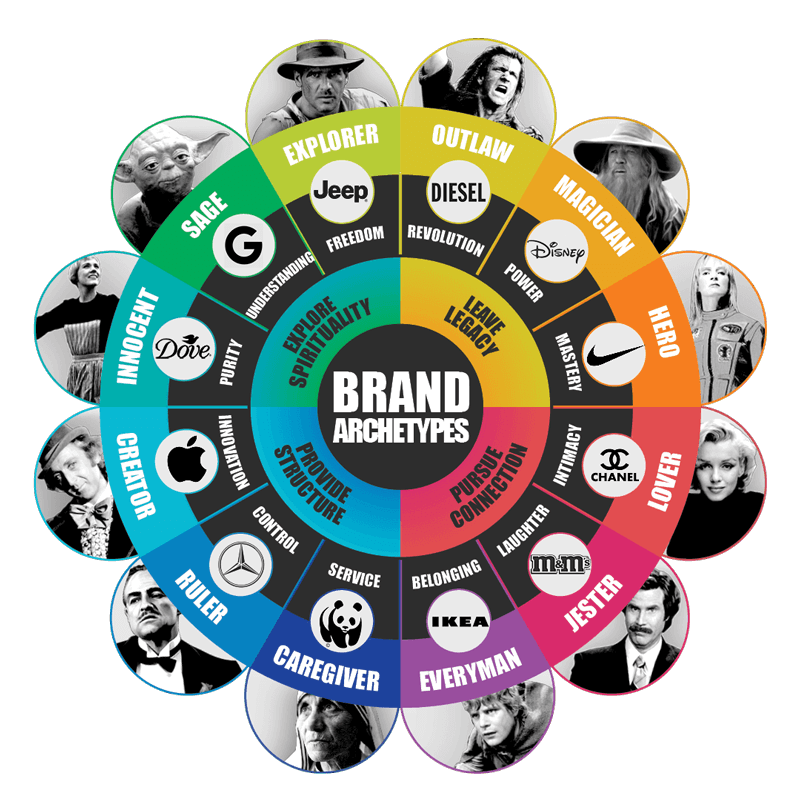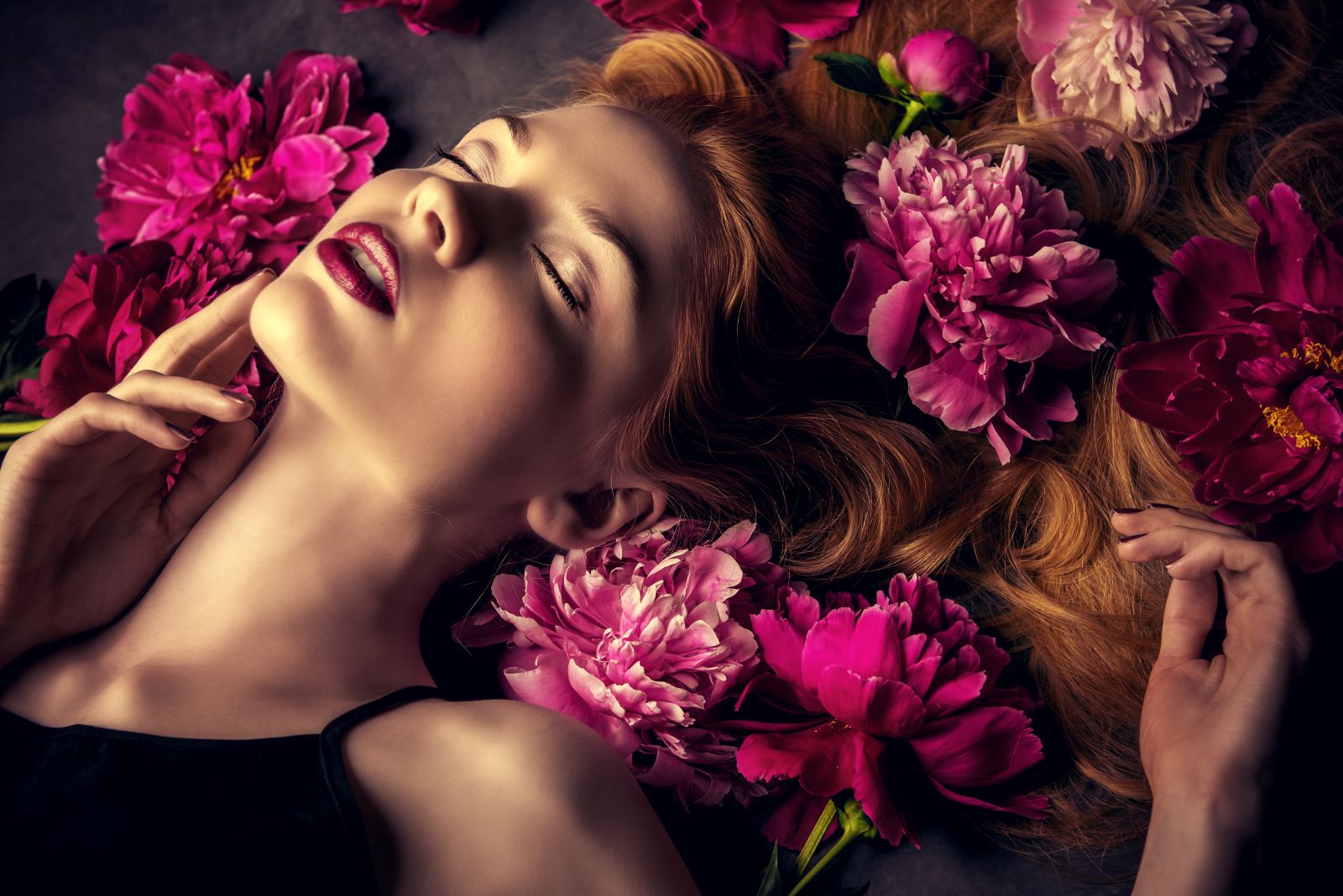Brand Archetypes in Marketing
In this fast-paced world of marketing, it’s all about standing out from the crowd and creating a killer brand identity. One powerful tool that has gained significant popularity in recent years is the concept of brand archetypes. By understanding and utilizing these personality archetypes, businesses can tap into the deep-rooted psychological and emotional connections that resonate with their target audience. In this article, we’ll explore the origin and popularization of brand archetypes, delve into the twelve archetypes, their relationships, and provide examples of well-known brands that embody each archetype.
Origin and Popularization of Brand Archetypes
The concept of brand archetypes originated from Swiss psychiatrist Carl Jung’s theories on the collective unconscious. Jung believed that individuals shared universal, symbolic patterns deeply ingrained in their subconscious minds. These patterns, or archetypes, served as fundamental building blocks for human behavior and emotions. In the 1980s, psychologist Margaret Mark and Carol S. Pearson recognized the potential of applying Jung’s archetypes to branding and introduced the concept to the marketing world through their book, “The Hero and the Outlaw.”
It wasn’t long before marketers caught wind of this goldmine and started harnessing archetypes to forge strong brand identities.
Fast forward to today, and these archetypes have become the secret sauce behind some of the most successful brands out there. We’re talking about the ones who’ve nailed their unique personalities and built connections that run deep. From the Innocent to the Jester, each archetype brings its own flavor and resonates with a specific audience.
Understanding What Brand Archetypes Represent
Archetypes tap into the deep-rooted psychology of human behavior and represent different facets of the human experience and personality. Rooted in psychology studies, these 12 archetypes are universal patterns and symbols that have resonated with individuals throughout history. They provide a framework for understanding and connecting with audiences on a profound level, embodying fundamental human desires, fears, and motivations, giving us a common language of understanding.
When applied to branding and marketing, archetypes become a powerful tool to tap into these shared experiences and create meaningful connections with our target audience. Each archetype represents a different facet of the human experience and personality, resonating with specific desires, values, and aspirations. This helps a brand to more authentically embody a particular personality or place in the market.
For example, the Hero archetype embodies the universal desire for triumph over adversity and the pursuit of greatness. It taps into our innate need for achievement and inspires individuals to take bold actions and overcome challenges. On the other hand, the Caregiver archetype represents the nurturing and compassionate side of humanity, fulfilling the desire to care for others and create a sense of security.
Each archetype represents a distinct set of motivations, values, and desires that resonate with different individuals. By aligning your brand with a specific archetype, you tap into these shared experiences and speak directly to the core of what drives your audience.

The Twelve Brand Archetypes
So, let’s break it down.
We’ve got twelve archetypes in the mix, each representing a different facet of the human personality, each with its own distinct characteristics and vibes. Picture them as points on a wheel, each connected to the other, forming a powerful network of archetypal energy.
The Innocent
The first stage of life and the first stop on the Brand Archetype wheel is The Innocent, which embodies purity, simplicity, and optimism. It evokes a sense of nostalgia and childlike wonder, appealing to the desire for a simpler and more wholesome life. Innocent brands often emphasize honesty, transparency, and a genuine belief in the goodness of the world.

The key characteristics of the Innocent brand archetype are:
- Simplicity and purity: Innocent brands strive for a pure and uncomplicated image. They embrace clean designs, simple messaging, and straightforward approaches to connect with their audience.
- Optimism and positivity: Innocent brands exude a positive outlook on life, focusing on the brighter side of things. They inspire hope, joy, and optimism in their messaging, making people feel good about themselves and the world around them.
- Trust and sincerity: Trustworthiness is essential for Innocent brands. They aim to establish a sincere and genuine relationship with their audience, emphasizing honesty, integrity, and reliability.
- Nostalgia and idealism: The Innocent archetype often taps into nostalgia, reminding people of simpler times and cherished memories. It evokes a sense of idealism, striving to create a world that reflects the purity and innocence of the past.
- Safety and comfort: Innocent brands create a sense of safety and comfort for their audience. They provide reassurance, stability, and a feeling of being taken care of.
Examples of brands that embody the Innocent archetype include:
- Coca-Cola: Coca-Cola has successfully portrayed itself as a timeless, refreshing, and innocent brand. Through its classic logo, wholesome advertising campaigns, and association with happy moments, Coca-Cola taps into the nostalgia and simplicity of childhood.
- Dove: Dove’s “Campaign for Real Beauty” has established the brand as an advocate for body positivity and self-acceptance. It promotes a sincere and honest message of embracing natural beauty, capturing the essence of the Innocent archetype. Their marketing is stark white like their product, invoking themes of purity, cleanliness, and freshness.
- Innocent Smoothies: The name itself suggests the Innocent archetype. Innocent Smoothies focuses on using natural ingredients, sustainability, and promoting a healthy lifestyle. Their quirky and playful branding evokes a sense of simplicity and innocence.
Incorporating the Innocent archetype into your own company’s marketing can be beneficial if your brand aligns with these characteristics. To utilize the Innocent archetype effectively, focus on creating a brand image that emphasizes simplicity, positivity, and trust. Use genuine and transparent messaging, evoke nostalgia if appropriate, and emphasize the safety and comfort your brand provides. By embracing the Innocent archetype, you can establish a deep emotional connection with your audience and foster long-lasting relationships based on trust and positivity.
The Everyman
The Everyman brand archetype represents relatability, down-to-earth values, and a genuine connection with everyday people. It resonates with the average person, focusing on inclusivity and a sense of belonging. The Everyman archetype embraces the notion that everyone has value and deserves recognition.

Here are the key characteristics of the Everyman brand archetype:
- Relatability: Everyman brands strive to be relatable and approachable to a wide audience. They understand the experiences, challenges, and aspirations of everyday individuals and communicate in a down-to-earth manner.
- Authenticity: Everyman brands prioritize authenticity, being genuine and true to themselves. They avoid pretentiousness and create a sense of trust by being transparent and relatable in their messaging.
- Humility: Humility is a central trait of the Everyman archetype. These brands don’t seek the spotlight or strive for extravagance. Instead, they emphasize modesty and humility, celebrating the value in simplicity.
- Community and inclusivity: Everyman brands foster a sense of community and inclusivity. They make people feel like they belong, emphasizing that everyone is important and has a place within their brand’s community.
- Practicality and affordability: Everyman brands focus on practical solutions and affordability. They offer products or services that cater to the everyday needs of their audience, ensuring accessibility for a wide range of individuals.
Examples of brands that embody the Everyman archetype include:
- IKEA: IKEA’s emphasis on affordable and functional furniture appeals to the Everyman archetype. They provide solutions that meet the needs of everyday people while emphasizing inclusivity and practicality. Nothing fancy, just a good sturdy end table and couch.
- Walmart: Walmart positions itself as a brand that offers low prices and a wide range of products, catering to the average consumer’s needs. It embodies the Everyman archetype by focusing on accessibility and affordability.
- Levi’s: Levi’s jeans have become a symbol of everyday, timeless fashion. The brand embraces the Everyman archetype by producing durable, practical, and affordable denim that connects with a broad audience, centered on the working man or woman and the legacy of rugged individualism.
- Subway: Subway markets itself as a brand offering fresh, customizable, and affordable sandwiches. It embodies the Everyman archetype by appealing to a wide range of individuals and emphasizing practicality in its offerings.
When incorporating the Everyman archetype into your own company’s marketing, consider highlighting relatable stories, focusing on authenticity, and creating a sense of inclusivity and community. Use messaging that emphasizes practicality and affordability, showcasing how your brand understands and addresses the no-nonsense needs of everyday people. By embracing the Everyman archetype, you can establish a genuine connection with your audience, fostering trust and loyalty among a broad range of individuals.
The Hero
The Hero brand archetype embodies strength, courage, and the desire for achievement. It inspires individuals to overcome challenges, strive for greatness, and become the best versions of themselves. Hero brands often focus on empowering their audience and offering solutions that help them overcome obstacles and achieve their goals.

Here are the key characteristics of the Hero brand archetype:
- Courage and determination: Hero brands exhibit bravery and a strong sense of purpose. They encourage individuals to face their fears, overcome obstacles, and persevere in the pursuit of their goals.
- Inspiration and motivation: Hero brands inspire and motivate their audience to take action. They provide a sense of hope and encourage people to believe in their abilities to create positive change in their lives and the world.
- Achievement and success: Hero brands emphasize achievement and success. They highlight stories of triumph, showcasing individuals who have overcome challenges and achieved remarkable results.
- Leadership and responsibility: Hero brands demonstrate leadership and a sense of responsibility. They guide and support their audience, offering solutions and resources to help them navigate their journeys and make a positive impact.
- Empowerment and transformation: Hero brands empower individuals, helping them transform their lives for the better. They provide tools, knowledge, and support to facilitate personal growth and development.
Examples of brands that embody the Hero archetype include:
- Nike: Nike, with its iconic “Just Do It” slogan, embodies the Hero archetype. The brand inspires individuals to push their limits, pursue their dreams, and embrace the mindset of champions. Their ad campaigns always align with heroic athletes and high achievers, further associating the brand with respected heroes.
- GoPro: GoPro, a manufacturer of action cameras, appeals to the Hero archetype by enabling individuals to capture their adventures and share their extraordinary experiences. The brand empowers people to become heroes of their own stories.
- FedEx: FedEx positions itself as a hero in the logistics industry, promising reliable and efficient delivery services. The brand showcases its ability to overcome challenges and deliver on its promises, positioning itself as a trusted ally for businesses and individuals.
- Gatorade: Gatorade, a sports beverage brand, embodies the Hero archetype by providing hydration and fuel to athletes. The brand supports individuals in their athletic pursuits, helping them push their boundaries and achieve peak performance.
When incorporating the Hero archetype into your own company’s marketing, consider emphasizing stories of triumph, highlighting the transformational journey, and providing resources that empower your audience. Use messaging and imagery that inspire and motivate individuals to take action and overcome challenges. Align your brand’s values with the heroic qualities of leadership, responsibility, and achievement. By embracing the Hero archetype, you can position your brand as a trusted guide and ally, empowering individuals to conquer their own obstacles and achieve greatness.
The Caregiver
The Caregiver brand archetype represents compassion, nurturing, and a genuine desire to support and care for others. Caregiver brands prioritize the well-being and happiness of their audience, offering products or services that provide comfort, support, and assistance. They strive to create a sense of trust and reliability, positioning themselves as reliable guides and sources of care.

Here are the key characteristics of the Caregiver brand archetype:
- Compassion and empathy: Caregiver brands demonstrate genuine concern and empathy for the well-being of their audience. They aim to alleviate pain, provide comfort, and meet the needs of those they serve.
- Nurturing and support: Caregiver brands offer nurturing and support to their audience. They provide guidance, assistance, and solutions that enhance the lives of others and contribute to their overall well-being.
- Trust and reliability: Caregiver brands prioritize trust and reliability. They establish a sense of dependability, ensuring their audience feels confident in their ability to provide the care and support needed.
- Selflessness and generosity: Caregiver brands embody selflessness and generosity. They prioritize the needs of others above their own and seek to make a positive impact in the lives of those they serve.
- Safety and protection: Caregiver brands create a sense of safety and protection. They aim to provide a secure environment, whether through physical safety or emotional support.
Examples of brands that embody the Caregiver archetype include:
- Johnson & Johnson: Johnson & Johnson, a healthcare company, exemplifies the Caregiver archetype through its range of products that prioritize the health and well-being of individuals and families. The brand’s emphasis on nurturing and support is evident in its messaging and commitment to care.
- UNICEF: UNICEF, a humanitarian organization, embodies the Caregiver archetype by advocating for the well-being and rights of children worldwide. The organization demonstrates compassion and empathy in its efforts to provide support, protection, and care to those in need.
- TOMS: TOMS, a footwear company, embraces the Caregiver archetype through its “One for One” giving model. For every pair of shoes purchased, TOMS donates a pair to someone in need. The brand’s commitment to giving back and supporting communities aligns with the nurturing and caring qualities of the Caregiver archetype.
When incorporating the Caregiver archetype into your own company’s marketing, consider emphasizing the care, support, and well-being that your products or services provide. Demonstrate compassion, reliability, and a genuine desire to make a positive impact in the lives of your audience. Use messaging, imagery, and experiences that evoke a sense of trust, nurturing, and protection. By embracing the Caregiver archetype, you can establish a strong emotional connection with your audience and position your brand as a caring and reliable source of support and assistance.
The Explorer
The Explorer brand archetype embodies curiosity, adventure, and the desire for discovery. Explorer brands inspire individuals to step out of their comfort zones, embrace new experiences, and embark on journeys of self-discovery. They evoke a sense of freedom, independence, and the thrill of exploring uncharted territories.

Here are the key characteristics of the Explorer brand archetype:
- Curiosity and adventure: Explorer brands foster a spirit of curiosity and adventure. They encourage individuals to seek out new experiences, explore the unknown, and push boundaries.
- Independence and self-discovery: Explorer brands promote independence and self-discovery. They inspire individuals to embark on personal journeys of growth, helping them uncover their true potential and find their own path.
- Courage and resilience: Explorer brands embody courage and resilience. They celebrate individuals who overcome challenges, persevere in the face of adversity, and embrace the unknown with determination.
- Freedom and escape: Explorer brands evoke a sense of freedom and escape. They offer a break from the ordinary, encouraging individuals to break free from routine and explore new possibilities.
- Connection with nature and the world: Explorer brands emphasize a connection with nature and the world. They promote environmental awareness, sustainability, and a deep appreciation for the beauty and diversity of the natural world.
Examples of brands that embody the Explorer archetype include:
- The North Face: The North Face, a renowned outdoor clothing and equipment brand, exemplifies the Explorer archetype. The brand celebrates the spirit of adventure and encourages individuals to explore the great outdoors, challenging themselves and embracing the beauty of nature.
- Airbnb: Airbnb embodies the Explorer archetype by providing unique travel experiences that allow individuals to explore new destinations, connect with local cultures, and immerse themselves in new environments. The brand enables individuals to be adventurous and discover the world in a more authentic way.
- National Geographic: National Geographic represents the Explorer archetype by promoting exploration, knowledge, and an appreciation for the world’s natural wonders. The brand inspires individuals to venture into unexplored territories and deepen their understanding of the planet.
- Patagonia: Patagonia, an outdoor apparel company, embraces the Explorer archetype by advocating for environmental protection and encouraging individuals to connect with nature. The brand promotes responsible exploration and fosters a sense of adventure while prioritizing sustainability.
When incorporating the Explorer archetype into your own company’s marketing, consider emphasizing the spirit of adventure, personal growth, and connection with nature. Inspire individuals to step out of their comfort zones, embrace new experiences, and discover their true potential. Use imagery, messaging, and experiences that evoke a sense of exploration, freedom, and connection with the world. By embracing the Explorer archetype, you can position your brand as a guide and source of inspiration for individuals seeking to embark on transformative journeys of self-discovery and exploration.
The Rebel or Outlaw
The Outlaw brand archetype represents rebellion, nonconformity, and a willingness to challenge the status quo. Outlaw brands often push boundaries, break the rules, and stand up against established norms. They inspire individuals to embrace their individuality, reject conformity, and carve their own paths.

Here are the key characteristics of the Outlaw brand archetype:
- Rebellion and nonconformity: Outlaw brands embody a spirit of rebellion, urging individuals to question authority and challenge societal norms. They reject the mainstream and encourage people to think differently.
- Authenticity and edginess: Outlaw brands prioritize authenticity, often embracing unconventional and edgy approaches in their branding and messaging. They embrace rawness, imperfections, and unconventional beauty.
- Disruption and provocation: Outlaw brands disrupt the status quo and provoke thought. They challenge existing systems, beliefs, and conventions, aiming to shake up the industry and spark conversations.
- Individuality and empowerment: Outlaw brands celebrate individuality and encourage people to express themselves authentically. They empower individuals to embrace their uniqueness and stand up for what they believe in.
- Counterculture appeal: Outlaw brands often appeal to counterculture movements and subcultures. They resonate with those who feel disconnected from mainstream society, offering a sense of belonging and acceptance.
Examples of brands that embody the Outlaw archetype include:
- Harley-Davidson: Harley-Davidson, a renowned motorcycle brand, epitomizes the Outlaw archetype. It represents freedom, rebellion, and the open road. Their brand image and marketing campaigns celebrate the spirit of individuality and nonconformity.
- Red Bull: Red Bull, an energy drink brand, portrays the Outlaw archetype through its extreme sports sponsorships and daring marketing campaigns. It appeals to adventurous individuals who crave excitement and challenge conventional limits.
- Dr. Martens: Dr. Martens, known for its iconic boots, has a long-standing association with counterculture and rebellious subcultures. The brand’s rugged, durable footwear has been embraced by punk, grunge, and alternative communities, symbolizing the spirit of rebellion.
When incorporating the Outlaw archetype into your own company’s marketing, consider embracing unconventional ideas, challenging industry norms, and empowering individuals to express their unique identities. Use provocative messaging, imagery, and experiences to resonate with your target audience. However, it’s crucial to align the Outlaw archetype with your brand’s values and target market to ensure authenticity and genuine connection. By embracing the Outlaw archetype, you can attract like-minded individuals who value individuality, rebellion, and the courage to challenge the established order.
The Lover
The Lover brand archetype represents passion, desire, and deep emotional connections. Lover brands seek to create intense and meaningful relationships with their audience. They emphasize sensuality, beauty, and the pursuit of pleasure, appealing to the desires and emotions of individuals.

Here are the key characteristics of the Lover brand archetype:
- Passion and desire: Lover brands evoke strong emotions and desires in their audience. They emphasize passion, romance, and a deep longing for connection.
- Sensuality and beauty: Lover brands celebrate sensuality and aesthetics. They focus on creating visually appealing experiences and products that stimulate the senses.
- Emotional connection: Lover brands strive to establish deep emotional connections with their audience. They understand their desires, dreams, and aspirations, and seek to fulfill them through their products or services.
- Intimacy and exclusivity: Lover brands create a sense of intimacy and exclusivity. They make their audience feel special, valued, and part of an exclusive community.
- Elegance and refinement: Lover brands often embody elegance, refinement, and sophistication. They pay attention to detail, craftsmanship, and exquisite design, elevating the overall experience for their audience.
Examples of brands that embody the Lover archetype include:
- Victoria’s Secret: Victoria’s Secret is a prime example of a Lover brand. Through its lingerie and beauty products, the brand emphasizes sensuality, desire, and the pursuit of intimate connections.
- Chanel: Chanel, the iconic fashion and beauty brand, embodies the Lover archetype through its timeless elegance and refinement. The brand appeals to individuals seeking a sophisticated and luxurious lifestyle.
- Godiva: Godiva, the renowned chocolatier, creates an experience of indulgence and pleasure, appealing to the senses and celebrating the love of chocolate. The brand captures the essence of the Lover archetype through its emphasis on exquisite taste and craftsmanship.
When incorporating the Lover archetype into your own company’s marketing, consider emphasizing the emotional appeal of your products or services. Create visually appealing and sensorial experiences that evoke desire and passion. Focus on personalization, exclusivity, and making your audience feel valued and special. Use imagery, messaging, and experiences that celebrate beauty, sensuality, and emotional connections. By embracing the Lover archetype, you can establish deep emotional bonds with your audience and create a brand that resonates with their desires, fostering loyalty and long-lasting relationships.
The Creator
The Creator brand archetype represents innovation, imagination, and the desire to bring something new into the world. Creator brands are driven by a passion for originality and self-expression. They encourage individuals to tap into their creative potential, think outside the box, and make a unique mark on the world.

Here are the key characteristics of the Creator brand archetype:
- Imagination and innovation: Creator brands embody imagination and foster a spirit of innovation. They inspire individuals to think creatively, challenge the status quo, and push the boundaries of what is possible.
- Self-expression and individuality: Creator brands celebrate self-expression and individuality. They encourage individuals to embrace their unique talents, ideas, and perspectives, empowering them to share their creations with the world.
- Authenticity and originality: Creator brands prioritize authenticity and originality. They value uniqueness and strive to offer something fresh and distinct, standing out from the crowd and avoiding conformity.
- Vision and inspiration: Creator brands have a clear vision and the ability to inspire others. They serve as catalysts for creativity, encouraging individuals to pursue their passions and bring their ideas to life.
- Craftsmanship and attention to detail: Creator brands exhibit a dedication to craftsmanship and attention to detail. They value quality and ensure that their creations are meticulously crafted, reflecting their commitment to excellence.
Examples of brands that embody the Creator archetype include:
- Apple: While the catchphrase “Think Different” has some rebel undertones, Apple’s overall brand identity is centered around being on the bleeding edge of tech innovation. They are the creator in the true sense, crafting beautiful and functionally superior products they’re proud of, showcasing them appropriately, and capturing the spirit of new ideas turned into great products.
- LEGO: LEGO, the iconic toy brand, exemplifies the Creator archetype by empowering individuals to build, create, and explore their imagination. The brand encourages endless possibilities and celebrates the act of constructing and bringing ideas to life.
- Adobe: Adobe, a software company, embraces the Creator archetype by providing tools and resources that empower individuals to unleash their creativity. The brand’s software, such as Photoshop and Illustrator, enables users to express themselves artistically and bring their visions to fruition.
- Etsy: Etsy, an online marketplace for handmade and unique products, embodies the Creator archetype by supporting independent artists, crafters, and creators. The brand provides a platform for individuals to showcase and sell their original creations, celebrating the spirit of creativity and entrepreneurship.
When incorporating the Creator archetype into your own company’s marketing, consider emphasizing the value of creativity, originality, and self-expression. Encourage individuals to tap into their creative potential and showcase their unique talents. Provide tools, resources, or platforms that empower your audience to bring their ideas to life. Use messaging, imagery, and experiences that evoke a sense of innovation, imagination, and craftsmanship. By embracing the Creator archetype, you can position your brand as a catalyst for creativity, inspiring individuals to embrace their creative instincts and make their unique mark on the world.
The Jester
The Jester brand archetype represents joy, humor, and lightheartedness. Jester brands aim to bring laughter, entertainment, and a sense of playfulness to their audience. They embrace spontaneity, creativity, and the ability to see the lighter side of life, often providing a welcome escape from the seriousness of everyday routines.

Here are the key characteristics of the Jester brand archetype:
- Humor and wit: Jester brands prioritize humor and wit. They use clever wordplay, puns, and comedic elements to entertain and engage their audience, bringing smiles and laughter to their faces.
- Lightheartedness and playfulness: Jester brands embody lightheartedness and playfulness. They encourage individuals to embrace their inner child, let go of inhibitions, and find joy in the present moment.
- Spontaneity and improvisation: Jester brands embrace spontaneity and improvisation. They are quick on their feet, adapting to situations with humor and creating memorable, unexpected moments.
- Entertainment and escapism: Jester brands provide entertainment and escapism. They offer a respite from the demands of everyday life, allowing individuals to temporarily escape into a world of fun and laughter.
- Challenging conventions: Jester brands challenge conventions and societal norms through humor and satire. They use their comedic platform to shed light on societal absurdities and encourage critical thinking in a lighthearted manner.
Examples of brands that embody the Jester archetype include:
- M&M’s: M&M’s, known for its colorful chocolate candies, embraces the Jester archetype through its playful and humorous advertising campaigns. The brand uses animated characters and witty dialogue to bring smiles and laughter to its audience.
- Old Spice: Old Spice, a brand of male grooming products, embodies the Jester archetype through its comedic and absurd commercials. The brand uses humor and surreal situations to entertain and engage its audience.
- Snickers: Snickers, a popular candy bar, embraces the Jester archetype by using humor to showcase relatable situations and exaggerate the effects of hunger. The brand’s “You’re not you when you’re hungry” campaign brings humor to everyday scenarios.
- Geico: Geico, an insurance company, embodies the Jester archetype through its humorous and memorable advertising campaigns. The brand uses quirky characters, unexpected situations, and comedic storytelling to entertain and engage its audience.
When incorporating the Jester archetype into your own company’s marketing, consider emphasizing humor, wit, and playfulness. Create entertaining and engaging content that brings joy to your audience. Use clever wordplay, comedic storytelling, or unexpected twists to capture attention and leave a lasting impression. By embracing the Jester archetype, you can position your brand as a source of laughter, entertainment, and lightheartedness, fostering positive emotional connections with your audience and creating memorable experiences.
The Sage
The Sage brand archetype represents wisdom, knowledge, and a thirst for truth. Sage brands are seen as experts in their fields, providing valuable insights and guidance to their audience. They prioritize learning, reflection, and the pursuit of knowledge, positioning themselves as trusted and respected sources of information and wisdom.

Here are the key characteristics of the Sage brand archetype:
- Wisdom and knowledge: Sage brands embody wisdom and possess a wealth of knowledge. They are seen as authorities in their fields, providing valuable information and insights to their audience.
- Insight and reflection: Sage brands encourage introspection and reflection. They inspire individuals to think deeply, question assumptions, and seek a deeper understanding of themselves and the world around them.
- Learning and education: Sage brands prioritize learning and education. They offer resources, courses, or experiences that empower their audience with knowledge and help them grow intellectually.
- Analytical and rational thinking: Sage brands emphasize analytical and rational thinking. They encourage critical analysis, evidence-based decision-making, and the use of logic to arrive at conclusions.
- Trust and credibility: Sage brands prioritize trust and credibility. They establish themselves as reliable sources of information, earning the confidence and respect of their audience through their expertise and integrity.
Examples of brands that embody the Sage archetype include:
- Google: Google, the renowned search engine, exemplifies the Sage archetype. It is a trusted source of information, providing access to a vast repository of knowledge and answers to people’s inquiries. Google’s emphasis on organizing information and making it universally accessible aligns with the Sage archetype.
- TED: TED, known for its inspiring talks and presentations, embodies the Sage archetype by sharing powerful ideas and insights from experts in various fields. The brand’s focus on spreading knowledge and promoting intellectual curiosity resonates with the Sage archetype.
- Harvard University: Harvard University represents the Sage archetype as a renowned institution of higher education and research. It is synonymous with academic excellence, intellectual rigor, and the pursuit of knowledge across diverse disciplines.
- The New York Times: The New York Times, a respected newspaper, embodies the Sage archetype through its commitment to in-depth journalism, investigative reporting, and analysis. The brand provides reliable news and insights, establishing itself as a trusted source of information.
When incorporating the Sage archetype into your own company’s marketing, consider emphasizing your brand’s expertise, knowledge, and commitment to education. Provide valuable content, resources, or experiences that empower your audience with insights and help them expand their understanding. Use messaging, imagery, and experiences that convey credibility, trust, and a commitment to intellectual growth. By embracing the Sage archetype, you can position your brand as a reliable source of wisdom, earning the trust and respect of your audience as you guide them on their quest for knowledge and understanding.
The Magician
The Magician brand archetype represents enchantment, transformation, and charismatic innovation. Magician brands tap into the power of imagination, mystery, and the ability to make dreams come true. They offer solutions that create awe and wonder, inspiring individuals to believe in the extraordinary and embrace transformation.

Here are the key characteristics of the Magician brand archetype:
- Enigmatic and transformative: Magician brands possess an aura of mystery and transformation. They have the power to turn dreams into reality and create magical experiences for their audience.
- Charismatic and visionary: Magician brands exude charisma and possess a visionary mindset. They inspire individuals with their innovative ideas and ability to see beyond what is currently possible.
- Imagination and creativity: Magician brands harness the power of imagination and creativity to bring their ideas to life. They encourage their audience to think outside the box and embrace new possibilities.
- Empowerment and change: Magician brands empower individuals by providing them with tools, knowledge, or experiences that facilitate personal growth and positive change. They enable their audience to transform their lives in extraordinary ways.
- Wonder and awe: Magician brands evoke a sense of wonder and awe in their audience. They create captivating experiences, leaving a lasting impression and making people believe in the extraordinary.
Examples of brands that embody the Magician archetype include:
- Disney: Disney is a prime example of a Magician brand. Through its theme parks, movies, and storytelling, Disney creates enchanting experiences that transport individuals to magical worlds and make dreams come true.
- Tesla: Tesla, led by Elon Musk, embodies the Magician archetype through its groundbreaking electric cars and visionary goals of sustainable energy. The brand has captured the imagination of the public and created a sense of awe around its innovative solutions.
- Cirque du Soleil: Cirque du Soleil is renowned for its awe-inspiring performances that combine acrobatics, music, and storytelling. The brand creates a mesmerizing experience, capturing the essence of the Magician archetype through its ability to transport and captivate its audience.
When incorporating the Magician archetype into your own company’s marketing, consider emphasizing innovation, creativity, and the transformative power of your products or services. Use storytelling and imagery that evoke wonder and inspire individuals to believe in the extraordinary. Provide tools, resources, or experiences that empower your audience to embrace positive change and personal transformation. By embracing the Magician archetype, you can position your brand as a catalyst for innovation and enchantment, creating a lasting impact on your audience and making their dreams come true.
The Ruler
The Ruler brand archetype represents power, authority, and leadership. Ruler brands strive to establish control, create order, and guide others toward success. They embody a sense of confidence and influence, positioning themselves as trusted experts and setting the standards within their industries.

Here are the key characteristics of the Ruler brand archetype:
- Power and authority: Ruler brands exude power and authority. They establish themselves as leaders within their respective fields, commanding respect and admiration from their audience.
- Confidence and control: Ruler brands exhibit confidence and control in their actions and decision-making. They inspire trust and create a sense of stability, providing a sense of assurance to their audience.
- Order and structure: Ruler brands emphasize order and structure. They set clear guidelines, establish processes, and create systems that promote efficiency and effectiveness.
- Vision and influence: Ruler brands have a clear vision and the ability to influence others. They provide guidance, set trends, and shape the direction of their industry, inspiring others to follow in their footsteps.
- Responsibility and accountability: Ruler brands take responsibility for their actions and are accountable for the impact they have on their audience and the wider community. They lead by example and hold themselves to high standards.
Examples of brands that embody the Ruler archetype include:
- Rolex: Rolex, a luxury watch brand, epitomizes the Ruler archetype. The brand’s precision, craftsmanship, and prestigious reputation establish it as a symbol of power, authority, and success.
- Mercedes-Benz: Mercedes-Benz represents the Ruler archetype through its reputation for luxury, performance, and cutting-edge technology. The brand positions itself as a leader in the automotive industry, symbolizing status and influence.
- American Express: American Express, a financial services company, embodies the Ruler archetype by offering exclusive benefits, premium services, and an aura of prestige. The brand establishes itself as a leader in the financial industry, catering to affluent individuals and businesses.
When incorporating the Ruler archetype into your own company’s marketing, consider emphasizing your brand’s expertise, authority, and ability to lead. Showcase your industry knowledge, highlight your achievements, and establish yourself as a trusted source of guidance and influence. Use messaging, imagery, and experiences that convey power, control, and professionalism. By embracing the Ruler archetype, you can position your brand as a leader, inspiring confidence and setting the standards within your industry.
Assessing Competitor Archetypes and Choosing Your Brand’s Unique Path
In the dynamic landscape of marketing, it’s essential to carve a distinct identity that resonates with your audience and sets your brand apart. One effective approach is to harness the power of brand archetypes. By understanding the archetypes employed by competitors and identifying untapped opportunities, you can position your brand as a trailblazer in the market.
To embark on this transformative journey, begin by researching and analyzing your competitors. Dive into their brand positioning, messaging, visual identity, and overall brand experience. Look for recurring themes, patterns, and characteristics that align with different archetypes. Assess how consistently they embody these archetypes across various touchpoints, as well as their audience’s perception and engagement with their brand.
By conducting a comprehensive competitive analysis, you can gain insights into the strengths and weaknesses of your competitors’ chosen archetypes. This evaluation will reveal areas where they excel and, more importantly, unveil opportunities for differentiation.
Once armed with this knowledge, it’s time to choose an untapped archetype that aligns with your brand’s unique value proposition. Reflect on your brand’s strengths, unique selling points, and the value you bring to your target audience. Consider market gaps where certain archetypes are underrepresented or fail to effectively meet audience needs.
To make an informed decision, evaluate your brand’s core values, mission, and strengths. Look for archetypes that harmonize with these attributes and have the potential to strongly resonate with your target audience.
But remember, authenticity is key. Assess whether the chosen untapped archetype aligns with your brand’s identity and if you can genuinely embody it. Ensure it aligns with your capabilities, resources, and long-term brand strategy.
Once you have chosen your untapped archetype, it’s time to put it into action. Develop targeted marketing strategies that effectively communicate and embody the chosen archetype. Craft messaging, visual elements, and experiences that capture the essence of this archetype and resonate deeply with your audience.
Throughout this transformative journey, remember to monitor audience response, seek feedback, and refine your approach accordingly. Embrace flexibility and agility as you navigate uncharted waters.
Choosing an untapped archetype provides an unparalleled opportunity to position your brand as a unique player in the market. By differentiating yourself authentically and providing a compelling brand experience, you can forge strong connections with your audience.
Embrace the untapped archetype, unleash your brand’s full potential, and leave an indelible mark in the hearts and minds of your audience. Let this be the catalyst for your brand’s evolution, guiding you toward a future where you stand out among competitors and shape the industry with your unique essence.
Utilizing Brand Archetypes in Marketing
To leverage brand archetypes effectively, it is crucial to understand your target audience and align your chosen archetype with their desires, values, and aspirations. Conduct thorough market research, surveys, and customer interviews to gain insights into their needs and preferences. This understanding will help you tailor your brand messaging and positioning to resonate with your audience on a deeper level.
Consistency is key when embodying your chosen archetype. Ensure that every aspect of your brand, from visual elements such as logo, color palette, and design aesthetics, to messaging, tone of voice, and brand personality, consistently reflects the core qualities of your archetype. This consistency helps in creating a strong brand identity and fostering recognition and trust among your audience.
Choose appropriate marketing channels and tactics that align with the emotions and connections associated with your archetype. For example, if you embody the Explorer archetype, consider leveraging social media platforms, travel blogs, or experiential marketing to create a sense of adventure and inspire exploration. If your brand archetype is the Sage, focus on thought leadership content, educational resources, or speaking engagements to position yourself as an expert and provide valuable insights to your audience.
Authenticity is crucial when leveraging brand archetypes. Ensure that your brand’s values and mission align with the core qualities of your chosen archetype. Your audience can easily discern genuine expressions from forced ones, so it’s important to stay true to your brand’s essence. Authenticity builds trust and fosters meaningful connections with your audience.
Remember, brand archetypes are powerful tools, but they are not a one-size-fits-all solution. It’s essential to adapt and customize your approach to suit your specific industry, target audience, and brand positioning. Regularly evaluate the effectiveness of your marketing efforts, gather feedback from your audience, and make adjustments as needed to ensure your brand archetype resonates with your audience and contributes to the overall success of your marketing strategy.
By leveraging brand archetypes effectively, you can create a strong and differentiated brand identity, establish emotional connections with your audience, and ultimately drive customer engagement and loyalty.
Brand archetypes offer a powerful framework for creating a lasting impression in the minds of consumers. By understanding the origin and essence of each archetype, as well as the interrelationships between them, businesses can strategically position their brands and foster deep emotional connections. Whether your brand aligns with the Innocent, the Rebel, or any other archetype, harnessing its power can elevate your marketing efforts to new heights, leaving a lasting impact on your audience and establishing your brand as a force to be reckoned with. Embrace the power of archetypes and let your brand story unfold! And if you’re ready to embark on this transformative journey, remember that Signal Interactive is here to guide you every step of the way.




